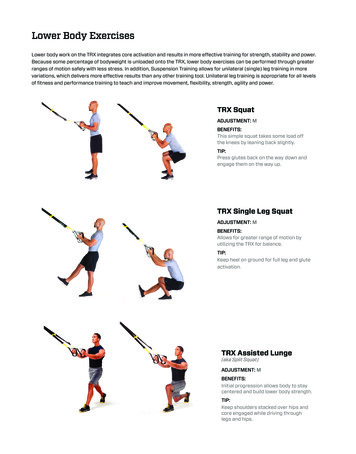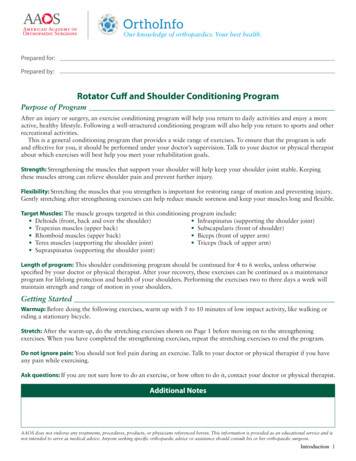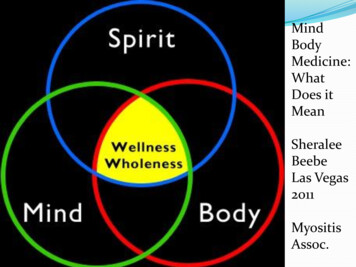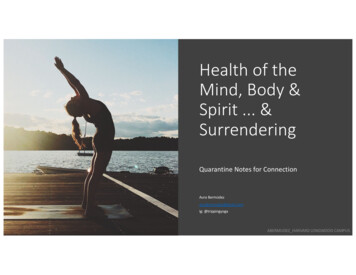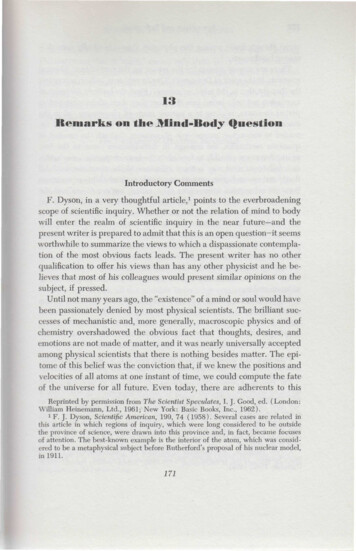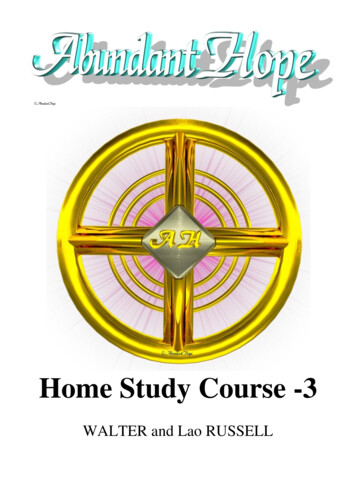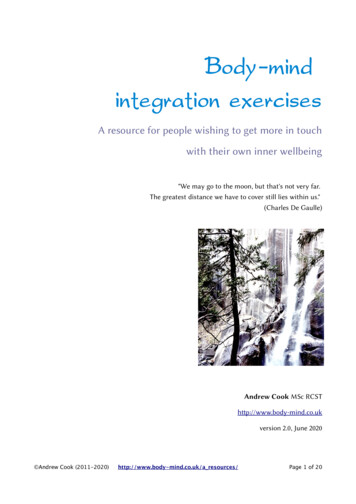
Transcription
Body-mindintegration exercisesA resource for people wishing to get more in touchwith their own inner wellbeing"We may go to the moon, but that's not very far.The greatest distance we have to cover still lies within us."(Charles De Gaulle)Andrew Cook MSc RCSThttp://www.body-mind.co.ukversion 2.0, June 2020 Andrew Cook (2011-2020)http://www.body-mind.co.uk/a resources/Page 1 of 20
Why integration?Probably the common factor behind every “alternative” healing technique is that the body onlybecomes unwell (“dis-eased”) when it loses its internal integrity.Parts of the physiology no longer work together, and/or parts of the self and identity are inconflict. The simple exercises below (and the resources listed at the end) are ways in which youcan use to explore your own internal integration, and use your conscious awareness in aconstructive and intelligent way to assist you own inner healing.When your body and mind are in full cooperation and mutual respect, then everything you dobecomes almost effortless. Healing takes place naturally and spontaneously. The emphasis is onthe mutual – because we have come to think that the mind is superior and can do whatever itwishes. However, the true relationship between the mind and the body (like the relationshipbetween the human being and the Earth) is not one of a slave-master and a slave, but one inwhich we are two beings that have grown together, and can be each others friend and equal.Each has its own sphere of responsibility and strength, and there is a proper relationship inwhich the conscious will should decide what you as a whole organism are oriented towards. Butthe body also has to take part in that. It does so willingly. But if the conscious mind does notmaintain the friendship and calibrate the body to its present circumstances, then the body goesoff and attempts to survive. And in doing so it removes much of itself from the domain of thewill, to the point that eventually the mind is run by the body. You may not believe thatdescription, but I would ask you to have an open mind and to notice your experiences as youtreat your body with respect and re-open important communication channels between the mindand body.I have personally used all of the exercises described below, and have found that they accelerateand strengthen the effects of the various therapies I have received. Furthermore the exercises aresafe; and require very little in the way of “belief” – other than believing that we have internalbodily senses (interoception), that we can hear ourselves, and what and how we say things toourselves is as important as what and how we say things to everyone else in our lives.At the very least they form the basis for a structured pain management programme and aresourcing guide for recovery from PTSD. At their greatest potential, they can be life-changing.Sources for the “exercises” include Sensorimotor Psychotherapy (a body-based approach totreatment of PTSD and other serious traumas), the Sedona Method, the teachings of BrunoGroening, the work of Milton Erickson, Max Freedom Long, HeartMath “Freeze-Frame”, MarshallRosenberg’s Non-Violent Communication , affirmations taught by people such as Shakti Gawainand Jack Canfield. And about 20 years of personal experience applying these for myself andteaching them to others to help them heal from physical pain and various kinds of trauma. Andrew Cook (2011-2020)http://www.body-mind.co.uk/a resources/Page 2 of 20
Some background informationThese exercises are designed to connect your waking conscious awareness with the healingresources in your body and, more generally, to help you to become more body-aware.This body awareness is important, because the physical body needs awareness to help it to be atits most healthy.This might be an unfamiliar idea. One way to explain it is that there is a template of health,which is not physical. This template needs consciousness to anchor and align it to the body.Another explanation is more psychological – in that much of what we consider to be our“personality” is driven by the workings of the physical body. A second is to note that there is astrong interaction between mind and body - so physical pain, injury, diet, exercise (or not), illnessetc. can affect how the mind works. And mental expectation (e.g. placebo, nocebo) can affect thehealth of the body. Looking at this constructively, it is possible to use the mind to increase bodilyhealth, and the body to stabilise the mind (and help it to be less noisy, more peaceful). A thirdexplanation is more associated with traditions which say that “energy follows the mind” – or inother words, wherever we put our attention is affected (even if we physically do nothing otherthan move our attention!) A fourth explanation might be that the body responds to how we“wield” our awareness of it, plays out whatever we think of as if we are personally doing it, andtakes not of the activity and focus of the mind as a guide for setting its priorities at a midbrainand hindbrain (i.e. non-conscious) level. So how we use our mind and attention moderates,informs and eventually educates instinctive and reflex actions.Clinically, I would say that all those explanations are correct, and there are probably lots of otherequally valid ways to describe aspects of the mind-body phenomenon. My observation as atherapist is that body tissue does not fully heal as easily and quickly as it might unless it is fullyaccessible to consciousness and the conscious mind has a positive relationship with it. As anexample, I once saw someone struggle for about a year with a knee operation that had gonewrong – there was a lot of pain and very poor mobility. Nothing worked until I finally persuadedthem to start to love the knee and thank it rather than hating it for the pain it was causing. Twoweeks later, it healed itself.Modern medicine has coined the term “psychoneuroimmunology” to describe the multipleinteractions between the mind/emotions, the nervous system, the immune system, and in factevery physiological system of the body. The conceptual medical model of a human as a machine,some 300 years old, which reached its height in the 1950’s has started to wane and gradually bereplaced by a model which is far more holistic. Scientific research has clearly shown that theemotions affect the rhythms of the heart, the production of hormones, the longevity of cells, andthe effectiveness of the immune system. So the simple exercises presented here contain severalthemes which are far larger than this small manual. Andrew Cook (2011-2020)http://www.body-mind.co.uk/a resources/Page 3 of 20
The themes we will touch, but which are far too large to discuss in any depth include : The nature of consciousness The relationship between consciousness and the body The different types of awareness and how these work together to form wakingconsciousness and the personality The relationship between psychological identity and the physical body The presence of a cellular, animal-level wisdom within the body The presence of an “inner wisdom” that you may possibly wish to think of as aconnection to a more universal ConsciousnessFundamental ingredientsThe exercises below fall into several broad categories which overlap, and are combined in recipesas ingredients of different proportions : the use of very specific word/language patterns to create a desired effect the deliberate use of awareness to highlight certain features or explore certain areas,or add emphasis in a particular way the deliberate cultivation and use of genuine heartfelt appreciation the use of intention an intention to communicate with, activate and cooperate with the self-healing forcesof the body deliberate choice to focus on “resources” rather than “problems” or pain Andrew Cook (2011-2020)http://www.body-mind.co.uk/a resources/Page 4 of 20
Language patternsMilton Erickson was confined to a wheelchair for all of his adult life after almost dying fromPolio at 17 years old. He devoted his life to studying and practicing psychology. Hisobservations of human behaviour made him realise that“the unconscious is highly separate from the conscious mind, with its own awareness,interests, responses, and learnings”.For Erickson, the unconscious mind was creative, solution-generating, and often positive. Hefound that there are very specific rules for language which is intended for use by thesubconscious (i.e. for instructing the subconscious to act in a particular way). e.g. One of these isthat the subconscious does not understand a negative – if you say “do not think about pinkelephants”, then immediately some part of the brain (and the subconscious) hears the instruction“think of pink elephants” Ericksoninan “clean” language is used in hypnotherapy, NLP, and Focussing, is one of theinfluences behind the Sedona Method, and is a strong influence on Marshall Rosenberg’s NonViolent Communication. It is particularly useful in that it offers “neutral” (non-directive)suggestions – i.e. it does not force any particular response. Rather, the question opens uppossibility and bypasses the simple yes/no polarity. In doing so, there is an implicit trust thatthere is an internal unconscious wisdom which will make greatest possible use of the opportunityprovided – far beyond what the conscious mind thinks to be its limitations.The idea of “neutral” suggestion is particularly important in all of the exercises. When trying tohave a particular effect or achieve a particular task, it is possible to be prejudiced, biased orneutral. If you are prejudiced, you will attempt to force the result you have pre-decided. If youare biased, you are saying that you think you know what you want, and you begin to move inthat direction, but are open to some better option if it comes along. Neutrality is to haveabsolutely no agenda – which is not easy if you are in pain – so neutrality is an ideal rather thanan absolute necessity. A neutral suggestion is in reality almost always a very lightly biasedsuggestion – we think we know which general direction we need to go in, but are very open tolistening to the response that our body/subconscious has and are prepared to trust and go alongwith what arises when we initiate a change. So at the least in these exercises we aim to be lightlybiased, and not prejudiced.When working with body wisdom it is important to always start, continue and finish from aposition of near-neutrality. The body knows how to heal itself, knows how to do that, and needsyour willing cooperation to make that possible. The task is to initiate a change and thencooperate with the “inner healer” until it has completed what it needs to complete. Andrew Cook (2011-2020)http://www.body-mind.co.uk/a resources/Page 5 of 20
The language of illnessAlso, it is important to recognise that many “illnesses” and pains have a purpose which needs tounfold before healing can take place. So another purpose of these exercises is to set up acommunication channel between the conscious mind and the body. There are many, manyadvantages to this which richly reward a small amount of patience.One reward is that we start to become aware of the times when our body is trying to tell ussomething important that we have been trying to ignore. It is surprising how often a pain ortension in a particular part of the body is expressing an emotion which the bearer does not wantto feel, and once the cause of the pain is recognised and the emotion “felt”, the pain justdisappears. Of course, this is not true for every case of pain or muscular tension, but it is alwaysworthwhile keeping an open mind and not discarding this possibility. This is just one practicalexample of the importance of neutrality/bias rather than prejudice. On the same lines, it isequally important NOT to assume that the pain is your fault for somehow not being aware ofsomething that you should be! My experience of working with chronic pain is that there is often(i.e. not always, but usually) an initial psychological element, as well as a physical one – and thatnon-physical component is the often (but not always) main reason that the pain has not goneaway. Added to that is the inevitable psychological response to a pain-filled body over weeks,months and years – called “central sensitisation”.Use of focussed awarenessConversely, the body also needs your conscious direction, which brings us to the use of will, focusand awareness. Many types of meditation and many “new age” spiritual practices (and old worldreligions for that matter) offer little practical advice on discrimination – what it is useful to beaware of and/or allow, and what it is NOT useful to be aware of and/or allow. It is surprisinglyeasy to tune into the body/unconscious and allow it to begin to move and express itself. This is avery powerful but two-edged sword. I see quite a few people (and have been one myself) whohave developed unusual physical twitches, by thinking that they are allowing healing to takeplace, but in reality they have got in a loop which then becomes habitual. If the same responseoccurs again and again, then you have reached a point where a higher level of skill is requiredthan you currently have, and at this point you probably need to get some external help todevelop that skill, or at least ask yourself what new questions you might ask yourself. There arealso many issues which require an external observer/witness and/or which require such subtletyof attentive power that it would take most people many years to develop adequate skill. So, likeany other task, it is important to be both optimistic and positive, whilst being also aware of ourlimitations. Andrew Cook (2011-2020)http://www.body-mind.co.uk/a resources/Page 6 of 20
The Inner HealersWe have evolved and survived as a species for hundreds of millions of years, and that has left uswith an enormously powerful birthright. We have several layers of intelligence in our bodies thatare capable of healing us on many different levels, and which are continuously available. In fact,it could be argued that almost any chronic debility or illness is essentially caused by a lost abilityto acknowledge, listen to, “embody”, welcome and cooperate with these layers of bodyintelligence and wisdom.The Attention-BubbleImagine yourself in a bar or restaurant with someone whom you wish to have an importantconversation; and suddenly the background music is turned up very loud. You are so interestedin the conversation that you ignore the noise, and suddenly notice in the back of you mind thatthe noise has almost disappeared as you focus on what your friend is saying. This ability to focusstrongly on anything is a skill which is very useful.So – what is it most useful to focus on? The first answer to that is that the body must be the firstfocus. But if there is pain, this is not an easy thing to do. So we make a choice.First, we acknowledge the area of our body that is in pain (or whatever else is calling ourattention), because after all it is there, and any attempt to deny it or get away from it or push itto one side will inevitably cause tension - and tension almost inevitably increases pain. And thenwe very simply and matter-of-factly choose to “look” for pleasant/warm/alive sensations in thebody. Instead of allowing our attention to be dragged by the most noisy thing there, we chooseto find the parts of our body that are totally healthy, and which know that fundamentally youare OK.With this intent to connect with physical sensation then other things might come into yourawareness – such as images, emotions, thought, memories; but the sensations in the physicalbody ideally retain at least 30-40% of your attention. Furthermore, the quality of that attentionmakes a big difference – see later for a more complete description of this important topic.In addition to the usual noisy sensation of pain (etc), I include in the term “body sensations”qualities such as heaviness, lightness, warmth, tingling, buzzing, density, shape, position,soft/hard, depth (skin, muscle, bone, etc), quality (if it were made of something what would thatsomething be?), volume (how big is that sensation, and how far does it extend?), colour, etc etc.the list of possibilities is very long. However, it is important to always look for a “What” – aqualitative sensory experience in whichever sense(s) you are using; and a “Where” – where is thepresence of that experience coming from? Andrew Cook (2011-2020)http://www.body-mind.co.uk/a resources/Page 7 of 20
I include states of consciousness – clarity, sleepiness, heaviness/lightness, alertness, intensity ofsensory connection, sensory balance (between the senses, internal/external, and between theskin, muscle and viscera, etc) in this experiential field. Sensations also include things like beingaware of the expression of the face (both emotionally and how the muscles feel in that position –stretched, loose, hard, soft, etc), contact with a chair or the floor, movement of the body withbreathing, etc. There is a vast range of combinations, and – generally speaking (provided that thecuriosity is not so effortful that it cuts you off from sensation) - the more you can exercise yourcuriosity and find the exact detail, the more effective will be your use of this exercise.AppreciationIt would seem (from scientific studies of heart rate and the immune system) that your body’sphysiology has evolved to be optimised when you are in a loving state. Putting that in a moreeasily understood form – your heart rate, breath and many other important rhythms of yourbody can (if necessary) work more or less independently of each other, but they work best whenthey are all “pulling together”, working to the same rhythmic pattern. Just like a troupe of circustrapeze artists, the organs and systems of the body can complement each other and support eachother when they are “swinging together”. The thing which creates that “swinging together” is theemotion of LOVE. When you are in a loving state, your heart works far more efficiently, andworks in time with your lungs and lymphatic system and autonomic nervous system (ANS) andthe Krebs (chemical energy/ATP) cycle – in fact the heart has to perform 15% less work when it isswinging in time with the ANS - and it does that when you feel the emotion of “love”.Love is quite a complex emotion. Just as anger can be felt as rage, irritation, frustration,indignation, irateness (not just different words, but also qualitatively different feelings), Loveoccurs in a “spectrum” encompassing the feelings of compassion, appreciation, acceptance, deepempathy, quiet joy, gratitude and forgiveness, and fades out into something else when theemotions of enthusiasm and excitement are reached. Of all this spectrum of emotion, the feelingof “heartfelt” (i.e. genuine) Appreciation is the most easy to access in a “pure” state. Lovingfeelings cannot be made up – if they are forced then it is essentially a form of fear. However, it ispossible to practice connecting to them – like learning how to walk to shops near your house, theroute soon becomes easy and familiar. Andrew Cook (2011-2020)http://www.body-mind.co.uk/a resources/Page 8 of 20
A list of the basicsPlace your attention on/in your body – become aware of your body Look especially for the parts which feel alive, comfortable, warm, pleasant, enjoyable. If youcan’t feel your body, or can’t find anywhere at all (not even a tiny little patch of skin) that feelscomfortable, then think of something natural and beautiful, like a waterfall or a forest, or asunrise and then observe whatever effect that has on how you feel – either emotionally orphysically or both.Take your time – the body works slower than your brain!Consider that (in becoming aware of your body) you are giving time to be with and talk to a goodfriend who you haven’t seen for yearsRemember that the body wants to protect and help you! In return, it is your job to look after itand teach it what is happening in each moment.Make yourself comfortable either (ideally) sitting with the back straight and unsupported, or ina comfortable chair, or lying down with a cushion under your knees. It is important to becomfortable – if necessary you can use lots of cushions to support you. I originally practiced thislying down, but now would personally prefer sitting upright (not slouched) or even standingbecause it helps the mind to be more clear. You choose which position is best for you.The room you are in should also be comfortable, or at least feel “safe” – the door closed, nobodylikely to barge in.It is sometimes useful to play music – if your mind is so busy that it won’t give you peace, thenmusic provides some respite from this. In which case, some sort of classical music is best (Bach,Mozart, Vivaldi, Tallis, Barber etc are all suitable). Drifty music will just end up, well, drifty, andmost folk and/or rock/pop music is not helpful for this kind of exercise because it stimulates theadrenal glands. However, if at all possible it is better to do the exercise in silence. Another useful“prop” is to have some flowers (or a picture or photograph of a beautiful scene from nature)nearby, which you can look at occasionally if your mind demands a change of scenery.A cautionNot everyone can easily be aware of the body. If there is trauma, then placing the attentiondirectly on the body is not necessarily a good thing, because memories may be released. In thatcase – or if you experience over-strong emotions or memories – focus on more externalsensations (contact/support) and consider seeking professional help. Andrew Cook (2011-2020)http://www.body-mind.co.uk/a resources/Page 9 of 20
Affirmations as a way to introduceyourself to body awarenessThe exact wording is important. I provide some graded alternatives which should NOT be mixedor changed. Start with the first one, use it for (e.g.) a day or two, or a week, then go on to thesecond . Whenever you connect verbally with a part of your body, it is also particularly usefulto make a sincere attempt to connect to that part from your heart. I would call this“appreciation”. This is done by SIMPLY by sincerely appreciating it for everything it has done foryou, and being lightly curious about the what/where details of the sensation. If you get a senseof “trying” or effort in this, then you are making it too complicated, not trusting yourself to beable to do it.A few possibilities are (choose one) :SIMPLE AWARENESS : “I now allow myself to be aware of this, my as best I as can in thismoment.” (and place your awareness on that part of your body, being aware of whatever comes toyour senses).POLARITY AWARENESS : “I now allow myself to be as aware of this, my as much as am inthis moment (pause, feel whatever there is) “ now allow myself to not feel this, my asmuch as I do in this moment (pause, be aware of the possibility of absences in your awareness, andallow them to be there).AWARENESS WITH LOVING ACCEPTANCE (OPEN) : “Could I now allow myself to love andaccept this, my as best I can in this moment.” (and place your awareness on that part of yourbody, being aware of whatever comes to your senses).AWARENESS WITH LOVING ACCEPTANCE (AFFIRMATION) : “I now love and accept (orappreciate) this, my exactly as it is in this moment.” (and place your awareness on that part ofyour body, being aware of whatever comes to your senses).AWARENESS WITH GRATITUDE : “I now give thanks to this, my for the support it has givenme throughout my life.” (and place your awareness on that part of your body, being aware ofwhatever comes to your senses).CURIOUS OPEN AWARENESS : “To what extent am I aware of in this moment ?” (andplace about 30% of your awareness on that part of your body and spread the remaining 70%everywhere else , being aware of whatever comes to your senses).Allowing the information to come to you (instead of using the senses like a laser or a torch) is askill that takes time to develop. It’s a letting go and trusting that you are actually aware of whatyou are aware of, and that is enough. Andrew Cook (2011-2020)http://www.body-mind.co.uk/a resources/Page 10 of 20
Thanking our body is particularly important. Parts which are healthy have usually worked 24/7without recognition for many, many years. Parts which are unwell are nevertheless trying theirbest, but are often disliked because of the pain which is present in them. Remember to noticeand thank the healthy, pain-free parts too!Go systematically and steadily through each part of your body in turn, saying the phrase youhave chosen, listening to the sound of words, feeling the sound of the words inside yourself, andfeeling the internal response. Speaking out loud is best (you can feel the vibrations of the soundsin your body), but this can equally be done in silence with an “internal voice”.This is also a ritual, and so the intention you come to it with is particularly important. One of itsmajor purposes is to give you an opportunity to sense what each part of your body is like, andwhat its’ (and your consciousness’s) response is to the words. As such it is time to be savouredand enjoyed – as best you can, find a sense of lightness rather than seriousness. You’re givingyourself time to appreciate yourself. The whole exercise is best done at least once every day forat least a couple of weeks.What do I mean by “each part of yourbody?”There is the physical body (limbs, torso, head) – which can also be subdivided into differentparts. The joints are as important is the large bits!There are the internal organs (Lungs, heart, liver/gallbladder, spleen/pancreas, stomach, smallintestine, large intestine, bladder, kidneys). These are particularly important. If you’re not surewhere they are, look at a simple anatomy book : Brain and nervous system; Sensory organs (eyes, ears, nose, taste); Immune system Hormone system. Pineal gland, pituitary, thyroid/parathyroid, Thymus (heart area),Adrenals, genitals Arteries, veins, lymphatic system and all the fluids of the body (I usually do these in onelot, or add the blood/circulation to the heart). Also the cavities and spaces in the body! Skin, muscles, connective tissues, fatty tissues, bones. The spine is particularly important,and I would always mention it specifically.I usually would finish off by doing one round for “all the cells” and then one for “my whole being”to bring everything together Andrew Cook (2011-2020)http://www.body-mind.co.uk/a resources/Page 11 of 20
Start short and simpleAs you can see from the above list, this could get to be quite long. Start by working with largechunks of your body at a time, so that the whole exercise only lasts about 10 minutes.Then, as you settle into the exercise over a few days or weeks you can become more detailed asyou wish. I would usually expect to apply this for a minimum of 10 minutes. If done verythoroughly the exercise can take over an hour, and so I would usually vary the detail to suit thetime available and what I want to achieve.Everything is good enough as it isAlthough you could call the phrases “affirmations”, they are NOT instructions. You get mostbenefit by allowing ANY response that IS - to happen. This includes pain, blankness, numbness,stiffness, or nothing, and also any mental/emotional responses, as well as things you wouldperhaps more normally expect. The important thing is to use the statement to set an intention,and then bring your consciousness to the REALITY of the moment. When you practice wholehearted acceptance, you can open up extraordinary new depths of integration in yourself. Youare sensing what your body is like IN THE EXACT MOMENT – not some memory of how it wasyesterday or last week, or even a few minutes ago. If you sense it in each moment, you will beginto notice a surprising amount of change. This change happens of itself, NOT because you haveforced it. Generally speaking, any attempt to force an outcome (prejudice instead of bias) willmake the exercise ineffective. We all would like to feel happy, pain free and all that. You have tostart with what is there (also - see “polarity” below).However, you don’t need to stay in pain or discomfort. One of the big points of this exercise isthat pain and discomfort (and distress) take over if we give them too much attention, so the ideais that you acknowledge and honestly feel whatever there is, and then move onto the nextwhatever. And you are perfectly free to choose to spend more time in parts o fthe body in whichthere are interesting and comfortable/healthy sensations.In fact, I would VERY STRONGLY recommend that you choose to focus more on sensations thatsay something like “I’m alive and I’m OK” rather than blank/numb sensations or biguncomfortable ones.Also see the “Positive Body Awareness” document, and the workshops I run online athttp://www.body-mind.co.uk/ Andrew Cook (2011-2020)http://www.body-mind.co.uk/a resources/Page 12 of 20
You should include parts of your bodythat are “unwell” or in pain.as a natural part of the whole “scan”. This is because you have probably up to now not had aparticularly good relationship with them. Recognise that – as parts of your living body - they aredoing their best.But other than that, do not give them any attention which is particularly different from any otherbody part. You might or might not notice a different internal response to them (which could evenbe as extreme as fear, or blanking out) – and the best thing you can do is to notice that response(whatever it is) and accept that too along with the more physical sensations. It is particularlyimportant to be self-honest as much as you can be, and to recognise that this part of your bodyhas served you well for years and years. Settling into an acceptance of whatever symptoms arethere will allow you to let go of attaching any importance to them - to let go of any mentalresistance to that body part, and so will releas
Groening, the work of Milton Erickson, Max Freedom Long, HeartMath “Freeze-Frame”, Marshall Rosenberg’s Non-Violent Communication , affirmations taught by people such as Shakti Gawain and Jack Canfield. And about 20 y

